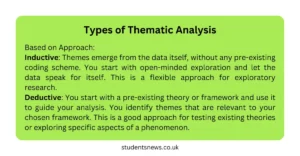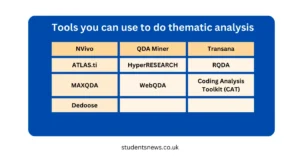Thematic analysis is a qualitative research method used to identify, analyze, and report patterns (themes) within data. It involves systematically examining the data to find repeated patterns of meaning. It has advantages as well as disadvantages.

Thematic analysis can be applied to a wide range of data, including interview transcripts, survey responses, media, and documents. The process generally involves six key phases:
- Familiarization with the data: Reading and re-reading the data, noting initial ideas.
- Generating initial codes: Systematically coding interesting features of the data in a meaningful and organized way.
- Searching for themes: Collating codes into potential themes, gathering all data relevant to each potential theme.
- Reviewing themes: Checking if the themes work in relation to the coded extracts and the entire dataset, generating a thematic map of the analysis.
- Defining and naming themes: Ongoing analysis to refine the specifics of each theme and the overall story the analysis tells, generating clear definitions and names for each theme.
- Producing the report: Final analysis and write-up of the report, linking back to the research question and literature.
Example of Thematic Analysis
Imagine a study exploring people’s experiences with remote work during the COVID-19 pandemic. Researchers conduct interviews with 20 participants and record their responses. Thematic analysis might proceed as follows:
- Familiarization with the data: Researchers read through the interview transcripts multiple times to immerse themselves in the data and start noticing recurring patterns.
- Generating initial codes: Researchers systematically code interesting features of the data, such as “work-life balance,” “communication challenges,” “productivity,” “technology issues,” and “mental health.”
- Searching for themes: Researchers look at the codes to identify broader patterns. For example, codes like “work-life balance,” “family distractions,” and “time management” might be grouped into a theme called “Balancing Work and Personal Life.”
- Reviewing themes: Researchers review the themes to ensure they accurately represent the data. They check if the themes make sense in relation to the coded data and the entire dataset.
- Defining and naming themes: Researchers refine and name the themes. They might end up with themes such as “Balancing Work and Personal Life,” “Technological Adaptation,” “Communication and Collaboration,” and “Mental Health Impacts.”
- Producing the report: Researchers write up their findings, using extracts from the interviews to illustrate each theme. They discuss how each theme relates to the research question and the existing literature on remote work.
Example of Themes and Quotes
- Balancing Work and Personal Life:
- “It was hard to separate work time from family time since my kids were always around.”
- “I found myself working odd hours just to catch up after dealing with household chores.”
- Technological Adaptation:
- “Getting used to all the new software was a steep learning curve, but necessary.”
- “Sometimes the internet would be so slow, making it hard to join meetings.”
- Communication and Collaboration:
- “We had to find new ways to communicate since we couldn’t just walk over to someone’s desk.”
- “Collaboration took a hit initially, but over time, we found tools that helped.”
- Mental Health Impacts:
- “The isolation really got to me; I missed the social interactions at the office.”
- “I felt anxious about the future and the uncertainty of the situation.”
Thematic analysis helps researchers make sense of large sets of qualitative data by breaking it down into manageable and interpretable themes, providing insights into the research questions being studied.
When is Thematic Analysis Used
Thematic analysis is a versatile method used in various contexts and for different types of research questions. Here are some common scenarios in which thematic analysis is particularly useful:
1. Exploratory Research
When researchers aim to explore new areas where little prior research exists, thematic analysis can help identify patterns and themes within qualitative data, providing a foundation for further study.
2. Understanding Experiences and Perceptions
Thematic analysis is ideal for studies focusing on understanding people’s experiences, perceptions, and feelings about a particular phenomenon. For instance, researchers might use it to analyze interview transcripts about patients’ experiences with healthcare.
3. Analyzing Complex and Rich Data
When dealing with large amounts of qualitative data, such as in-depth interviews, focus groups, or open-ended survey responses, thematic analysis helps in organizing and interpreting the data to uncover underlying themes.
4. Evaluating Programs and Interventions
In program evaluation, thematic analysis can be used to analyze feedback and qualitative responses from participants, providing insights into the effectiveness and impact of the program or intervention.
5. Developing Theories
Researchers can use thematic analysis to develop new theories or refine existing ones by identifying key themes that emerge from the data and linking them to theoretical frameworks.
6. Identifying Patterns Across Cases
Thematic analysis allows for the identification of patterns and themes across different cases or settings, which can be useful in comparative studies or when looking for commonalities in diverse datasets.
7. Policy Research
In policy research, thematic analysis can help in understanding stakeholders’ views, public opinion, or the impact of policies by analyzing qualitative data from interviews, focus groups, or public comments.
8. Humanities and Social Sciences Research
Researchers in fields like psychology, sociology, education, and anthropology often use thematic analysis to analyze textual data, such as narratives, media content, and cultural artifacts, to understand social phenomena.
Example Scenarios:
- Health Research: Investigating patients’ experiences with a chronic illness to identify themes related to coping strategies, emotional impact, and healthcare experiences.
- Education Research: Analyzing teachers’ narratives about their experiences with remote teaching to uncover themes related to challenges, technological adaptation, and student engagement.
- Business and Management Research: Exploring employees’ perceptions of organizational change to identify themes around resistance, communication, and impact on job performance.
- Media Studies: Analyzing media coverage of a significant event to identify themes in how the event is framed and discussed in different media outlets.
- Psychological Research: Examining individuals’ stories of personal growth following a traumatic experience to identify common themes of resilience, support, and transformation.
Thematic analysis is chosen for its flexibility and ability to provide detailed and nuanced insights into qualitative data, making it suitable for a wide range of research questions and disciplines.
Step 1: Familiarization with the Data

Familiarization with the data is the first and crucial step in thematic analysis. During this phase, researchers immerse themselves in the data to gain a deep understanding and start noting preliminary ideas for coding and themes. This process involves repeatedly reading the data, which helps in identifying patterns, meanings, and significant details.
Example Scenario
Imagine we are conducting a study on people’s experiences with remote work during the COVID-19 pandemic. We have collected interview transcripts from 5 participants.
Process
- Read through the entire dataset: Read all the transcripts multiple times to get an overall sense of the content.
- Take notes: Jot down initial thoughts, patterns, and potential codes.
- Highlight key passages: Mark important quotes and sections that stand out.
Example Data (Extracts from Interview Transcripts)
| Participant | Transcript Extract | Initial Notes |
|---|---|---|
| P1 | “Working from home was challenging at first because of the constant distractions from my kids.” | Challenges, distractions, family |
| P2 | “I found that setting up a dedicated workspace really helped me stay focused.” | Strategies, dedicated workspace, focus |
| P3 | “The lack of face-to-face interaction made me feel isolated and less motivated.” | Isolation, lack of motivation, social interaction |
| P4 | “Using video calls for meetings was initially awkward, but we adapted over time.” | Adaptation, technology, video calls |
| P5 | “Balancing work and household responsibilities was tough, but flexible hours made it a bit easier.” | Work-life balance, flexibility, household responsibilities |
Initial Notes Table
| Participant | Initial Notes |
|---|---|
| P1 | Challenges, distractions, family |
| P2 | Strategies, dedicated workspace, focus |
| P3 | Isolation, lack of motivation, social interaction |
| P4 | Adaptation, technology, video calls |
| P5 | Work-life balance, flexibility, household responsibilities |
Steps in Familiarization
- Reading and Re-reading: Go through each transcript multiple times to become familiar with the content.
- Noting Down Initial Ideas: Write down initial ideas and patterns that seem important.
- Highlighting Key Quotes: Highlight and annotate key quotes that seem relevant to the research question.
Example Notes and Highlights
Participant 1 (P1)
- Transcript Extract: “Working from home was challenging at first because of the constant distractions from my kids.”
- Initial Notes: Challenges, distractions, family
Participant 2 (P2)
- Transcript Extract: “I found that setting up a dedicated workspace really helped me stay focused.”
- Initial Notes: Strategies, dedicated workspace, focus
Participant 3 (P3)
- Transcript Extract: “The lack of face-to-face interaction made me feel isolated and less motivated.”
- Initial Notes: Isolation, lack of motivation, social interaction
Participant 4 (P4)
- Transcript Extract: “Using video calls for meetings was initially awkward, but we adapted over time.”
- Initial Notes: Adaptation, technology, video calls
Participant 5 (P5)
- Transcript Extract: “Balancing work and household responsibilities was tough, but flexible hours made it a bit easier.”
- Initial Notes: Work-life balance, flexibility, household responsibilities
By thoroughly familiarizing themselves with the data, researchers set the stage for the next steps in the thematic analysis process, ensuring they are well-prepared to generate initial codes and eventually identify meaningful themes.
Step 2: Generating Initial Codes
Generating initial codes is the second step in thematic analysis, where researchers start organizing the data in a meaningful and systematic way. Codes are the building blocks of analysis that capture interesting features of the data related to the research question.

This process involves identifying and labeling segments of data that appear significant.
Process
- Identify segments of data: Read through the data to identify segments that seem interesting or relevant to the research question.
- Label these segments with codes: Assign a code (a brief label) to each segment that captures the essence of the feature or idea.
- Systematic approach: Ensure the entire dataset is covered methodically to maintain consistency.
Example Scenario
Continuing with our study on people’s experiences with remote work during the COVID-19 pandemic, we have collected interview transcripts from 5 participants.
Example Data (Extracts from Interview Transcripts)
| Participant | Transcript Extract | Initial Notes | Codes |
|---|---|---|---|
| P1 | “Working from home was challenging at first because of the constant distractions from my kids.” | Challenges, distractions, family | Distractions, Family, Challenges |
| P2 | “I found that setting up a dedicated workspace really helped me stay focused.” | Strategies, dedicated workspace, focus | Dedicated workspace, Focus |
| P3 | “The lack of face-to-face interaction made me feel isolated and less motivated.” | Isolation, lack of motivation, social interaction | Isolation, Lack of motivation, Social interaction |
| P4 | “Using video calls for meetings was initially awkward, but we adapted over time.” | Adaptation, technology, video calls | Video calls, Adaptation, Technology |
| P5 | “Balancing work and household responsibilities was tough, but flexible hours made it a bit easier.” | Work-life balance, flexibility, household responsibilities | Work-life balance, Flexibility, Household responsibilities |
Steps in Generating Initial Codes
- Identify Segments of Data: Carefully read through the transcripts to find segments that appear significant.
- Label Each Segment with Codes: Assign concise labels that capture the essence of each segment.
- Systematic Approach: Ensure a methodical and consistent approach to coding the entire dataset.
Coding Example
Participant 1 (P1)
- Transcript Extract: “Working from home was challenging at first because of the constant distractions from my kids.”
- Codes: Distractions, Family, Challenges
Participant 2 (P2)
- Transcript Extract: “I found that setting up a dedicated workspace really helped me stay focused.”
- Codes: Dedicated workspace, Focus
Participant 3 (P3)
- Transcript Extract: “The lack of face-to-face interaction made me feel isolated and less motivated.”
- Codes: Isolation, Lack of motivation, Social interaction
Participant 4 (P4)
- Transcript Extract: “Using video calls for meetings was initially awkward, but we adapted over time.”
- Codes: Video calls, Adaptation, Technology
Participant 5 (P5)
- Transcript Extract: “Balancing work and household responsibilities was tough, but flexible hours made it a bit easier.”
- Codes: Work-life balance, Flexibility, Household responsibilities
Example Table of Codes
| Participant | Transcript Extract | Initial Notes | Codes |
|---|---|---|---|
| P1 | “Working from home was challenging at first because of the constant distractions from my kids.” | Challenges, distractions, family | Distractions, Family, Challenges |
| P2 | “I found that setting up a dedicated workspace really helped me stay focused.” | Strategies, dedicated workspace, focus | Dedicated workspace, Focus |
| P3 | “The lack of face-to-face interaction made me feel isolated and less motivated.” | Isolation, lack of motivation, social interaction | Isolation, Lack of motivation, Social interaction |
| P4 | “Using video calls for meetings was initially awkward, but we adapted over time.” | Adaptation, technology, video calls | Video calls, Adaptation, Technology |
| P5 | “Balancing work and household responsibilities was tough, but flexible hours made it a bit easier.” | Work-life balance, flexibility, household responsibilities | Work-life balance, Flexibility, Household responsibilities |
By systematically generating initial codes, researchers can organize and categorize data in a way that facilitates the identification of patterns and themes in subsequent steps. This process ensures that all relevant aspects of the data are captured and ready for further analysis.
Step 3: Searching for Themes
In this step, researchers begin to organize the initial codes into potential themes. Themes are broader patterns that capture significant aspects of the data related to the research question. This phase involves sorting and collating the different codes into themes and sub-themes.
Process
- Review Codes: Examine the initial codes to identify how they can be grouped into broader themes.
- Organize Codes into Themes: Group related codes together to form overarching themes.
- Create Sub-Themes if Necessary: For complex themes, create sub-themes to capture more detailed patterns within a larger theme.
- Collate Relevant Data: Gather all relevant data extracts for each theme.
Example Scenario
Continuing with our study on remote work experiences during the COVID-19 pandemic, we now organize our codes into themes.
Example Data (Codes and Themes)
| Participant | Codes | Themes |
|---|---|---|
| P1 | Distractions, Family, Challenges | Balancing Work and Family |
| P2 | Dedicated workspace, Focus | Productivity and Workspace |
| P3 | Isolation, Lack of motivation, Social interaction | Social and Emotional Impact |
| P4 | Video calls, Adaptation, Technology | Technological Adaptation |
| P5 | Work-life balance, Flexibility, Household responsibilities | Balancing Work and Family |
Steps in Searching for Themes
- Review Codes: Look at all initial codes to identify patterns and connections.
- Organize Codes into Themes: Combine codes into potential themes.
- Create Sub-Themes: Break down complex themes into sub-themes if needed.
- Collate Relevant Data: Collect all data extracts that fit each theme.
Thematic Map Example
| Theme | Sub-Themes | Codes |
|---|---|---|
| Balancing Work and Family | – | Distractions, Family, Challenges, Work-life balance, Household responsibilities |
| Productivity and Workspace | – | Dedicated workspace, Focus |
| Social and Emotional Impact | – | Isolation, Lack of motivation, Social interaction |
| Technological Adaptation | – | Video calls, Adaptation, Technology |
Step 4: Reviewing Themes
Reviewing themes involves refining the themes developed in the previous step. This phase ensures that the themes accurately reflect the data and are coherent and meaningful.
Process
- Review Collated Extracts for Each Theme: Check if the data supports each theme.
- Refine Themes: Split, combine, or discard themes as necessary.
- Create a Thematic Map: Develop a clear and organized map of the themes.
- Ensure Themes Reflect the Dataset: Confirm that the themes cover all relevant data and do not overlap excessively.
Steps in Reviewing Themes
- Review Collated Extracts: Go through the data extracts for each theme to ensure they are coherent and fit well together.
- Refine Themes: Adjust themes to better capture the data’s meaning. This may involve splitting broad themes into more specific sub-themes or combining similar themes.
- Develop a Thematic Map: Create a visual representation of the themes and their relationships.
- Check Against the Dataset: Ensure all relevant data is represented and that the themes do not overlap too much.
Refined Themes Example
| Theme | Sub-Themes | Refined Codes |
|---|---|---|
| Balancing Work and Family | Challenges, Strategies | Distractions, Family, Work-life balance, Household responsibilities |
| Productivity and Workspace | Strategies, Environment | Dedicated workspace, Focus |
| Social and Emotional Impact | Isolation, Social Interaction | Isolation, Lack of motivation, Social interaction |
| Technological Adaptation | Adaptation, Tools | Video calls, Technology, Adaptation |
Thematic Map Example
- Balancing Work and Family
- Challenges
- Distractions
- Family
- Strategies
- Work-life balance
- Household responsibilities
- Challenges
- Productivity and Workspace
- Strategies
- Dedicated workspace
- Focus
- Strategies
- Social and Emotional Impact
- Isolation
- Lack of motivation
- Social Interaction
- Social interaction
- Isolation
- Technological Adaptation
- Adaptation
- Video calls
- Tools
- Technology
- Adaptation
By systematically organizing and refining the themes, researchers ensure that their analysis accurately captures the key patterns and meanings within the data, setting the stage for the final stages of defining, naming, and reporting themes.
Step 5: Defining and Naming Themes
In this step, researchers refine each theme, ensuring that each one is clear, well-defined, and accurately captures the data’s meaning. The goal is to articulate what each theme represents and how it relates to the research question.
Process
- Refine Themes: Review and adjust themes to ensure clarity and distinctiveness.
- Define Themes: Write detailed descriptions of each theme, explaining what it captures and why it is significant.
- Name Themes: Assign concise, descriptive names to each theme that reflect their essence.
Example Scenario
Continuing with our study on remote work experiences, we now define and name our refined themes.
Refined Themes Example
| Theme | Description | Name |
|---|---|---|
| Balancing Work and Family | This theme captures the challenges and strategies related to balancing work duties and family responsibilities while working from home. | Balancing Work and Family |
| Productivity and Workspace | This theme highlights how the work environment and strategies to maintain focus affect productivity during remote work. | Productivity and Workspace |
| Social and Emotional Impact | This theme explores the emotional and social effects of remote work, including feelings of isolation and changes in motivation. | Social and Emotional Impact |
| Technological Adaptation | This theme covers the use of technology in remote work, including the adaptation to new tools and methods. | Technological Adaptation |
Steps in Defining and Naming Themes
- Refine Themes: Ensure each theme is clear and distinct.
- Define Themes: Provide detailed descriptions for each theme.
- Name Themes: Choose concise and descriptive names.
Detailed Descriptions and Names
1. Balancing Work and Family
- Description: This theme captures the dual responsibilities of managing work and family life. It includes the challenges of dealing with distractions, the strategies employed to maintain a balance, and the impact on both work and family dynamics.
- Name: Balancing Work and Family
2. Productivity and Workspace
- Description: This theme focuses on how remote workers create and maintain productive workspaces. It includes the importance of having a dedicated workspace, strategies for staying focused, and the role of the physical environment in productivity.
- Name: Productivity and Workspace
3. Social and Emotional Impact
- Description: This theme explores the emotional and social consequences of remote work. It covers feelings of isolation, changes in motivation, and the impact on social interactions and relationships.
- Name: Social and Emotional Impact
4. Technological Adaptation
- Description: This theme examines the role of technology in remote work. It includes the initial challenges of adapting to new tools, ongoing technological issues, and the eventual adaptation and integration of technology into daily work routines.
- Name: Technological Adaptation
Step 6: Producing the Report
The final step involves writing up the results of the thematic analysis in a coherent and compelling manner. The report should provide a detailed account of the themes, supported by data extracts, and relate back to the research question and literature.
Process
- Write a Detailed Account of Themes: Describe each theme in detail, providing context and interpretation.
- Use Data Extracts: Include quotes and examples from the data to illustrate each theme.
- Relate to Research Question and Literature: Connect the themes to the original research question and existing literature.
- Review and Revise: Ensure the report is clear, coherent, and accurately represents the data.
Example Scenario
Continuing with our study on remote work experiences, we now write the final report.
Report Example
Introduction
- Overview of the study’s purpose and research question.
- Brief description of the data collection and analysis methods.
Theme 1: Balancing Work and Family
- Description: This theme captures the dual responsibilities of managing work and family life. It includes the challenges of dealing with distractions, the strategies employed to maintain a balance, and the impact on both work and family dynamics.
- Data Extracts:
- “Working from home was challenging at first because of the constant distractions from my kids.” (P1)
- “Balancing work and household responsibilities was tough, but flexible hours made it a bit easier.” (P5)
- Interpretation: Many participants struggled with balancing work and family responsibilities, leading to the development of various strategies to manage these challenges.
Theme 2: Productivity and Workspace
- Description: This theme focuses on how remote workers create and maintain productive workspaces. It includes the importance of having a dedicated workspace, strategies for staying focused, and the role of the physical environment in productivity.
- Data Extracts:
- “I found that setting up a dedicated workspace really helped me stay focused.” (P2)
- Interpretation: Having a dedicated workspace was crucial for maintaining productivity, as it helped minimize distractions and create a work-focused environment.
Theme 3: Social and Emotional Impact
- Description: This theme explores the emotional and social consequences of remote work. It covers feelings of isolation, changes in motivation, and the impact on social interactions and relationships.
- Data Extracts:
- “The lack of face-to-face interaction made me feel isolated and less motivated.” (P3)
- Interpretation: The shift to remote work had significant social and emotional impacts, with many participants experiencing feelings of isolation and decreased motivation.
Theme 4: Technological Adaptation
- Description: This theme examines the role of technology in remote work. It includes the initial challenges of adapting to new tools, ongoing technological issues, and the eventual adaptation and integration of technology into daily work routines.
- Data Extracts:
- “Using video calls for meetings was initially awkward, but we adapted over time.” (P4)
- Interpretation: Adapting to new technology was a common challenge, but over time, participants developed proficiency and integrated these tools into their work routines.
Conclusion
- Summary of key findings.
- Discussion of how the themes relate to the research question.
- Implications for future research and practice.
By systematically documenting the themes and supporting them with data extracts, the final report provides a comprehensive and insightful analysis of the data, offering valuable contributions to the research field.



[…] Thematic analysis is a qualitative research method that involves identifying, analyzing, and reporting patterns or themes within a dataset. […]
[…] are several tools and approaches that researchers may use for thematic analysis. Here are some commonly used thematic analysis […]
[…] report aims to analyze and evaluate the current marketing strategies of M&S, focusing on how the company positions itself in the […]
[…] Thematic analysis is a method of analyzing qualitative data by identifying, analyzing, and reporting patterns (themes) within the data. […]